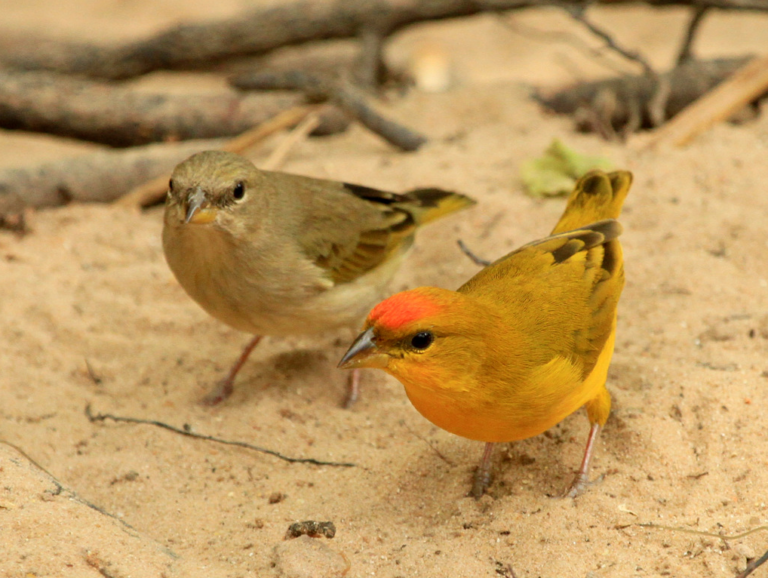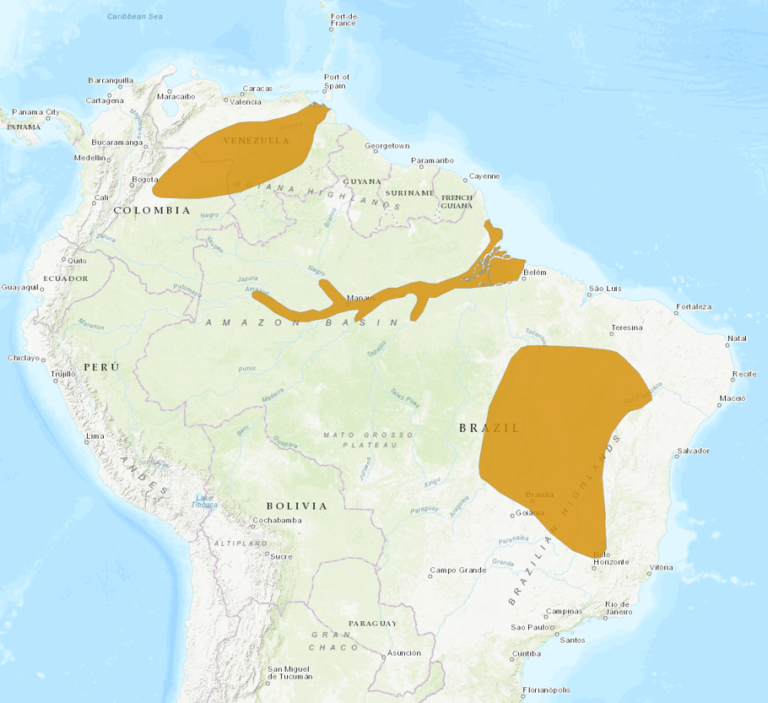Birdfinding.info ⇒ Uncommon over much of its range, but locally common and often easy to find along major rivers, including the Orinoco and Amazon. In Brazil, consistent sites include the Amazonian cities Manaus and Santarém, and towns along the Rio São Francisco such as Pirapora and Januária. Reliably found at many destination ranches in the Llanos, including Hato La Aurora and Hato Mata de Palma in Colombia, and Hato El Cedral in Venezuela.
Orange-fronted Yellow-Finch
Sicalis columbiana
Tropical savannas of South America. Usually associated with water; river floodplains in particular. Often occurs in settlements and agricultural areas.
The three recognized subspecies occupy discrete regions: (1) columbiana in the Llanos of eastern Colombia and Venezuela; (2) goeldii in Amazonian Brazil—mainly eastern Amazonas and northern Pará, and more locally in savannas of the Rio Negro, northern Rondônia, central Roraima, and southern Amapá; and (3) leopoldinae in the cerrado and caatinga biomes in the interior of eastern Brazil, locally from northeastern Maranhão and Ceará to eastern Mato Grosso, southwestern Goiás, and central Minas Gerais.
Populations are concentrated along the main stems of five large river systems: Orinoco, Amazon, Araguaia, Tocantins, and São Francisco.
Recorded from Trinidad once in an extended event: in 1926 several individuals and at least one nest were discovered near San Juan (identification to species was confirmed by the collection of multiple specimens).
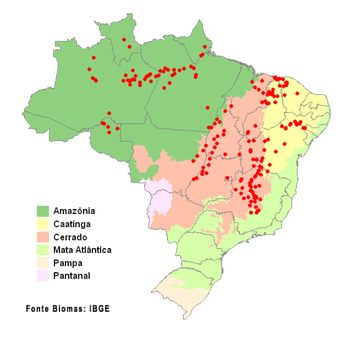
Brazilian records by municipality, showing concentrations along major rivers. © WikiAves 2021
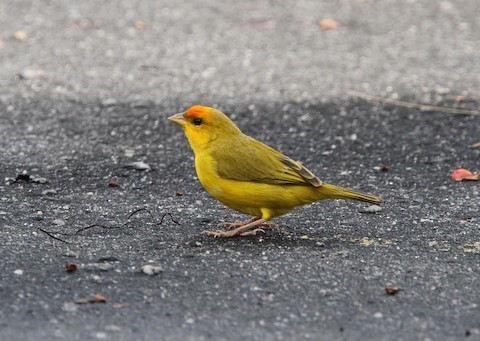
Male Orange-fronted Yellow-Finch in a hotel parking lot on the outskirts of Manaus, along the Brazilian Amazon. (August 22, 2011.) © Ian Thompson
Identification
A small yellow-finch that generally resembles the more familiar Saffron Finch, but is smaller, sharper-billed, and sexually dimorphic. (For a more detailed comparison, see Notes below.)

Orange-fronted Yellow-Finch, male. (Careiro da Várzea, Amazonas, Brazil; August 19, 2017.) © Robson Czaban
Male is vivid yellow overall with a distinct orange patch on the forehead and olive wings and tail.
The male’s lores are usually dark, sometimes blackish, which can be a helpful field mark, but it varies. On some individuals the dark shade extends behind the eye as an eyeline or partial mask, but others have little or no dark shading around the eyes.
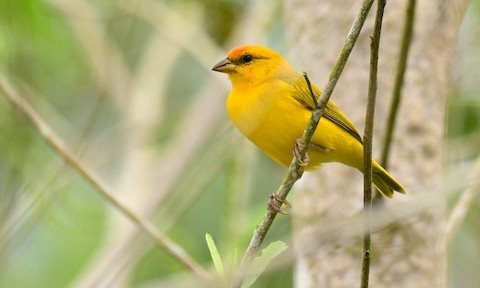
Orange-fronted Yellow-Finch, male showing blackish eyeline. (Ilha Nova, Careiro da Várzea, Amazonas, Brazil; May 30, 2018.) © Luiz Moschini

Orange-fronted Yellow-Finch, male in a richly colored plumage. (Manaus, Amazonas, Brazil; October 20, 2015.) © Pedro Perez
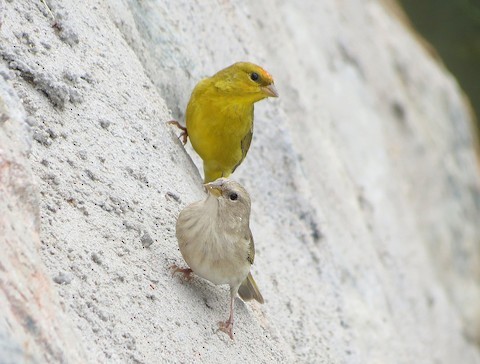
Orange-fronted Yellow-Finch, male in a dull olive-yellow plumage, with a plain-gray female showing vague streaking on the breast. (Paulo Afonso, Bahia, Brazil; December 31, 2019.) © Elby Anderson A. Silva
Female is mostly plain-gray with olive wings and tail. Often shows a faint whitish eyebrow, contrasting dark lores (or eyeline, as in the male), and faint, broad streaking on the back and breast.

Orange-fronted Yellow-Finch, female. (Hato Mata de Palma, Casanare, Colombia; January 25, 2018.) © Nicole Desnoyers

Orange-fronted Yellow-Finch, female. (Hato El Cedral, Apure, Venezuela; December 18, 2012.) © Karla Perez Leon
Immatures generally resemble females but many (perhaps only the young males) are washed with yellow or olive overall.

Orange-fronted Yellow-Finch, immature—note dusky lores. (Puerto López, Meta, Colombia; December 11, 2020.) © Adriana Vitolo

Orange-fronted Yellow-Finch, immature—note olive wash and dusky lores. (Iranduba, Amazonas, Brazil; August 22, 2016.) © Ester Ramirez
Subadult males resemble adults but with yellow instead of orange on the forehead.

Orange-fronted Yellow-Finch, immature male molting into brighter yellow plumage. (Balbina, Amazonas, Brazil; November 14, 2015.) © Laerte Cardim
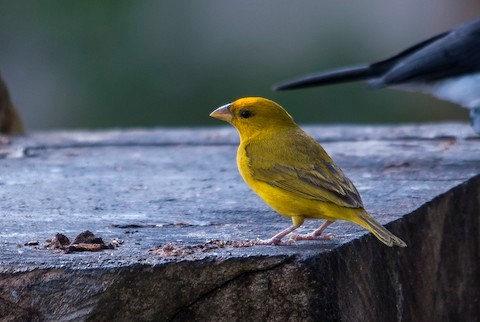
Orange-fronted Yellow-Finch, subadult male. (Hato El Cedral, Apure, Venezuela; March 11, 2011.) © Markus Craig
Notes
Polytypic species consisting of three recognized subspecies.
See below for comparison of Orange-fronted Yellow-Finch with Saffron Finch.
Cf. Saffron Finch. Saffron Finches of both sexes and male Orange-fronted Yellow-Finch are very similar and easily confused where they overlap (and often flock together): in the Llanos, interior eastern Brazil, and central Amazonia (where Saffron has been introduced). Both are predominantly vivid yellow with some orange in the face, but Orange-fronted has a specific and distinctive facial pattern that includes blackish lores (sometimes extending behind the eye as an eyeline or partial mask) and a discrete orange patch on the forecrown. Saffron’s facial pattern is more variable and less distinct—usually yellow overall, shading to orange on the forehead and lores.
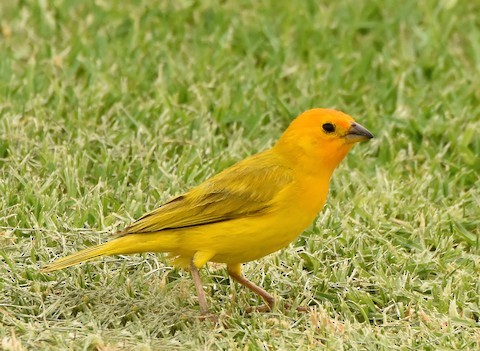
Saffron Finch, S. f. flaveola, male showing typically yellow-orange lores. (Waikoloa Village Golf Club, Big Island, Hawaii; July 30, 2015.) © Steven Mlodinow

Orange-fronted Yellow-Finch, male with minimally dark lores—yet still noticeably duskier than on Saffron. (Santarém, Pará, Brazil; January 6, 2012.) © Valdir Hobus
Structurally, Orange-fronted is somewhat smaller than Saffron, which is noticeable when they occur side-by-side, and the bills differ: Saffron’s is darker, shorter, and blunter, whereas Orange-fronted’s is paler, longer, and sharper-tipped. Typical leg color differs as well: Saffron’s legs tend to be grayish, whereas Orange-fronted’s tend to be pale pink. Bill and leg color vary somewhat in both species, so they are sometimes strongly indicative but not usually diagnostic.
Female and immature plumages differ significantly. Female Orange-fronted is mostly plain-gray with olive wings and tail, unlike any plumage of Saffron. Immature Orange-fronted is unstreaked and variably grayish, olive, or yellowish, whereas immature Saffron tends to show irregular bright-yellow blotches.

Saffron Finch, S. f. flaveola, immature, showing largely gray plumage with streaked upperparts and blotchy yellow wash. (Dorado, Puerto Rico; September 2, 2013.) © Ernesto Burgos
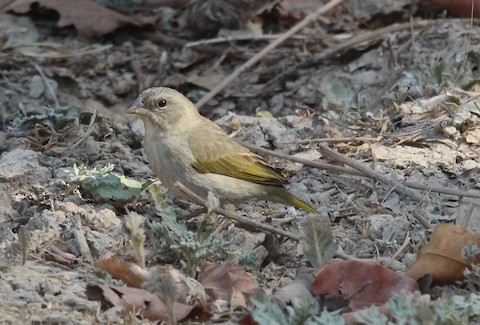
Orange-fronted Yellow-Finch, female showing typical unmarked gray plumage with olive wings and tail. (Hato La Aurora, Casanare, Colombia; February 27, 2019.) © Paul van Els

Orange-fronted Yellow-Finch, immature showing grayish plumage with olive and yellow wash. (Ilha Nova, Careiro da Várzea, Amazonas, Brazil; May 30, 2018.) © Luiz Moschini
The maximum potential for confusion is between the female Saffron and subadult male Orange-fronted—both of which typically show little or no orange on the face or forecrown. For such ambiguous individuals, consistent distinctions appear to be Orange-fronted’s dark lores and paler, longer, sharper bill.

Orange-fronted Yellow-Finch, an apparent subadult male with an indistinct facial pattern—but note that the lores are not yellow. (Hato El Cedral, Apure, Venezuela; December 18, 2012.) © Karla Perez Leon

Saffron Finch, S. f. brasiliensis, sex indeterminate but plumage seems more consistent with female (or relatively plain male)—note yellow lores and faint streaking on the back. (Marabá, Pará, Brazil; July 3, 2021.) © Luiz Matos
Additional Photos of Orange-fronted Yellow-Finch
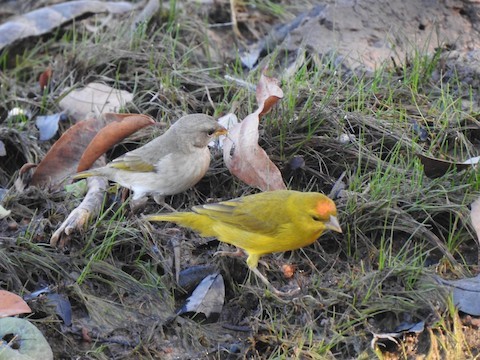
Orange-fronted Yellow-Finch, drab, gray female at left beside colorful male. (Autónomo Pedro Camejo, Cinaruco Capanaparo National Park, Apure, Venezuela; December 15, 2018.) © Joana & Luis Rivero
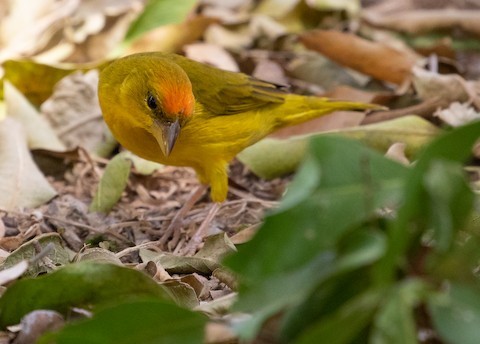
Orange-fronted Yellow-Finch, male. (Hato La Aurora, Casanare, Colombia; March 1, 2021.) © George Armistead

Orange-fronted Yellow-Finch, male. (Amazon Ecopark Jungle Lodge, Amazonas, Brazil; July 24, 2015.) © Magin Torres

Orange-fronted Yellow-Finch, male showing maximum orange on the forecrown. (Ilha Nova, Careiro da Várzea, Amazonas, Brazil; July 12, 2016.) © Per Smith
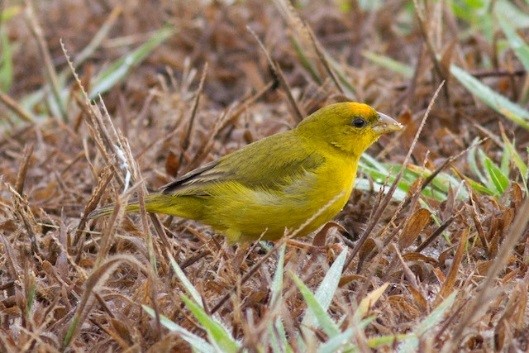
Orange-fronted Yellow-Finch, male. (Hato Mata de Palma, Casanare, Colombia; January 25, 2018.) © Justyn Stahl

Orange-fronted Yellow-Finch, male showing distinct orange patch on forecrown. (Hotel Tropical, Manaus, Amazonas, Brazil; August 22, 2011.) © Ian Thompson

Orange-fronted Yellow-Finch, subadult male. (Hato El Cedral, Apure, Venezuela; January 31, 2007.) © Lars Petersson

Orange-fronted Yellow-Finch, subadult male. (Fazenda Porto Alegre, Amazonas, Brazil; November 25, 2020.) © Wayne Paes

Orange-fronted Yellow-Finch, adult male and subadult male. (Várzea do Iranduba, Amazonas, Brazil; July 16, 2020.) © Fabio Olmos
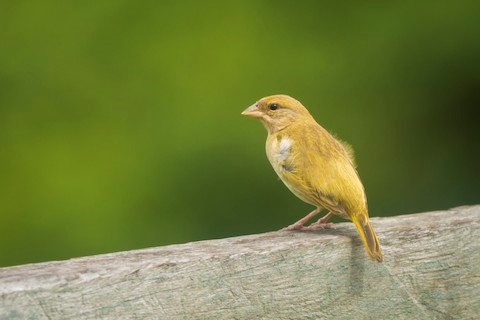
Orange-fronted Yellow-Finch, immature. (Ariaú Amazon Towers Hotel, Amazonas, Brazil; November 16, 2013.) © Cláudia Brasileiro
References
Ascanio, D., G.A. Rodriguez, and R. Restall. 2017. Birds of Venezuela. Christopher Helm, London.
BirdLife International. 2018. Sicalis columbiana. The IUCN Red List of Threatened Species 2018: e.T22723341A132162037. https://dx.doi.org/10.2305/IUCN.UK.2018-2.RLTS.T22723341A132162037.en. (Accessed September 22, 2021.)
eBird. 2021. eBird: An online database of bird distribution and abundance. Cornell Lab of Ornithology, Ithaca, N.Y. http://www.ebird.org. (Accessed September 22, 2021.)
ffrench, R. 2012. A Guide to the Birds of Trinidad & Tobago (Third Edition). Cornell University Press.
McMullan, M., and T. Donegan. 2014, Field Guide to the Birds of Colombia (Second Edition). Fundación Proaves de Colombia, Bogotá.
Ridgely, R.S., and G. Tudor. 1989. The Birds of South America, Volume I: The Oscine Passerines. University of Texas Press.
Ridgely, R.S., and G. Tudor. 2009. Field Guide to the Songbirds of South America: The Passerines. University of Texas Press.
van Perlo, B. 2009. A Field Guide to the Birds of Brazil. Oxford University Press.
Wikiaves. 2021. Canário-do-amazonas, https://www.wikiaves.com.br/wiki/canario-do-amazonas. (Accessed September 22, 2021.)
Xeno-Canto. 2021. Orange-fronted Yellow Finch – Sicalis columbiana. https://www.xeno-canto.org/species/Sicalis-columbiana (Accessed September 22, 2021.)
